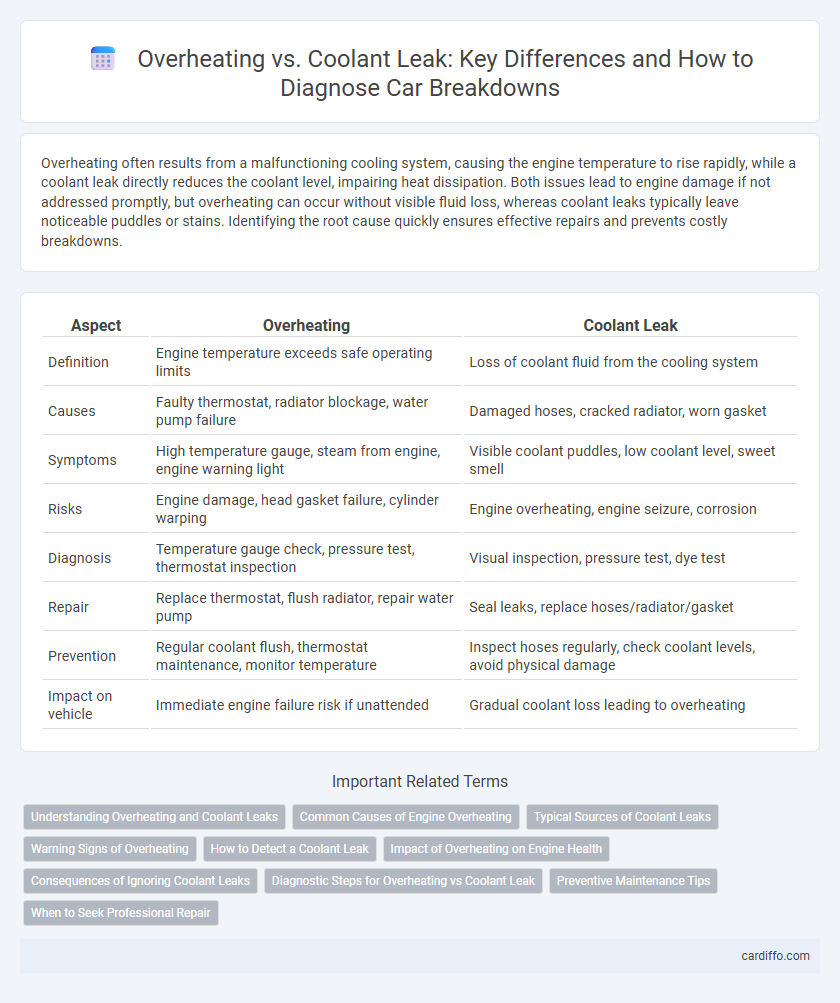Overheating often results from a malfunctioning cooling system, causing the engine temperature to rise rapidly, while a coolant leak directly reduces the coolant level, impairing heat dissipation. Both issues lead to engine damage if not addressed promptly, but overheating can occur without visible fluid loss, whereas coolant leaks typically leave noticeable puddles or stains. Identifying the root cause quickly ensures effective repairs and prevents costly breakdowns.
Table of Comparison
| Aspect | Overheating | Coolant Leak |
|---|---|---|
| Definition | Engine temperature exceeds safe operating limits | Loss of coolant fluid from the cooling system |
| Causes | Faulty thermostat, radiator blockage, water pump failure | Damaged hoses, cracked radiator, worn gasket |
| Symptoms | High temperature gauge, steam from engine, engine warning light | Visible coolant puddles, low coolant level, sweet smell |
| Risks | Engine damage, head gasket failure, cylinder warping | Engine overheating, engine seizure, corrosion |
| Diagnosis | Temperature gauge check, pressure test, thermostat inspection | Visual inspection, pressure test, dye test |
| Repair | Replace thermostat, flush radiator, repair water pump | Seal leaks, replace hoses/radiator/gasket |
| Prevention | Regular coolant flush, thermostat maintenance, monitor temperature | Inspect hoses regularly, check coolant levels, avoid physical damage |
| Impact on vehicle | Immediate engine failure risk if unattended | Gradual coolant loss leading to overheating |
Understanding Overheating and Coolant Leaks
Overheating occurs when the engine temperature rises beyond safe levels due to insufficient cooling, often caused by issues such as a malfunctioning thermostat or blocked radiator. Coolant leaks lead to a loss of antifreeze, reducing the cooling system's efficiency and causing the engine temperature to spike. Identifying the source of overheating and pinpointing coolant leaks through visual inspection and pressure testing is crucial for timely repair and preventing severe engine damage.
Common Causes of Engine Overheating
Engine overheating commonly results from coolant leaks that reduce the coolant level, impairing the system's ability to regulate temperature. A faulty radiator, broken water pump, or damaged thermostat can disrupt coolant flow, causing the engine to overheat. Additionally, blocked hoses and a malfunctioning cooling fan contribute significantly to rising engine temperatures.
Typical Sources of Coolant Leaks
Coolant leaks commonly originate from damaged radiator hoses, faulty water pumps, or cracked engine blocks, leading to engine overheating if not promptly addressed. Leaks may also arise from a worn-out radiator cap, defective thermostat housing, or degraded head gaskets, each compromising the cooling system's integrity. Identifying these typical sources early can prevent severe engine damage and costly repairs related to coolant loss.
Warning Signs of Overheating
Warning signs of overheating include a rising temperature gauge, steam or smoke coming from under the hood, and a burning smell. The engine may also make unusual noises or lose power during an overheating event. Recognizing these symptoms early can prevent severe damage compared to a coolant leak, which typically presents with puddles under the vehicle or low coolant levels.
How to Detect a Coolant Leak
Detecting a coolant leak involves inspecting the engine bay for visible puddles or stains of green, orange, or pink fluid beneath the vehicle, often near the radiator or hoses. A persistent sweet smell inside the cabin or around the engine is a key indicator of a coolant leak, alongside fluctuating engine temperature gauges signaling overheating risks. Regularly checking the coolant reservoir for low fluid levels without external spillage can help identify leaks before they cause serious breakdowns.
Impact of Overheating on Engine Health
Engine overheating can cause severe damage to critical components, including warped cylinder heads, blown head gaskets, and piston seizure. The excessive heat degrades lubrication, leading to increased friction and accelerated wear on engine parts. Persistent overheating ultimately reduces engine lifespan and significantly increases repair costs.
Consequences of Ignoring Coolant Leaks
Ignoring coolant leaks in a vehicle can lead to severe engine overheating, causing warping or cracking of the cylinder head and extensive engine damage. Prolonged overheating results in reduced lubrication efficiency, increasing friction and wear on engine components, ultimately leading to costly repairs or complete engine failure. Timely detection and repair of coolant leaks are critical to maintaining optimal engine temperature and preventing breakdowns caused by overheating.
Diagnostic Steps for Overheating vs Coolant Leak
Diagnosing overheating involves checking the engine temperature gauge, inspecting the radiator and cooling fan operation, and assessing the thermostat function to ensure proper coolant flow. For coolant leaks, examine hoses, radiator, water pump, and heater core for visible signs of fluid loss or staining, and use a pressure test to identify hidden leaks under pressure. Accurate differentiation allows for targeted repairs preventing engine damage and ensuring vehicle reliability.
Preventive Maintenance Tips
Overheating often results from low coolant levels or a malfunctioning cooling system, while coolant leaks reduce the system's efficiency and can lead to engine damage. Regularly inspecting radiator hoses, coolant levels, and the thermostat ensures optimal engine temperature control and prevents breakdowns. Flushing the coolant system and replacing worn seals or gaskets as part of preventive maintenance minimizes risks associated with overheating and leaks.
When to Seek Professional Repair
Engine overheating often signals urgent issues such as a failing radiator or thermostat, necessitating immediate professional repair to prevent severe damage. Coolant leaks, while sometimes less dramatic, can lead to engine overheating if left unaddressed, making timely diagnosis and repair by a certified mechanic essential. Ignoring these symptoms increases the risk of costly repairs, including warped cylinder heads or engine seizures, emphasizing the importance of expert intervention at the first sign of overheating or coolant leakage.
Overheating vs coolant leak Infographic

 cardiffo.com
cardiffo.com